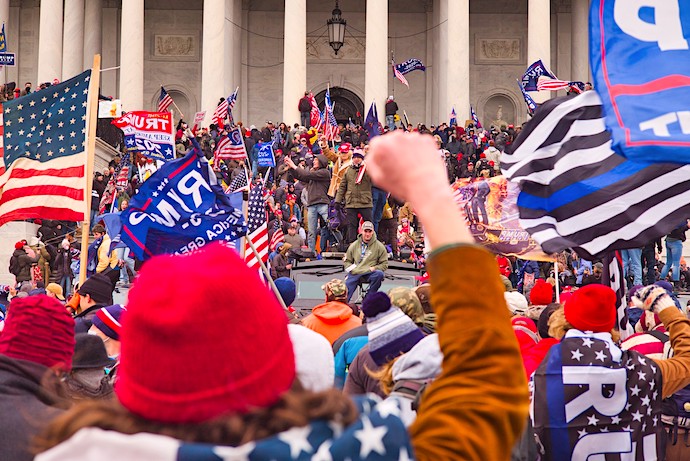Almost as soon as the tear gas cleared from the Capitol grounds on Jan 6, multiple stories emerged. About what happened, and when, and who was responsible. A year later, we can look back and see that accountability for the events of that day mirror the inequity that constitutes contemporary America. Consequences are unevenly distributed. Those with the least resources and fewest connections have suffered the most. Those with the most responsibility for lies about election fraud, driving the ideas that motivated the crowd that day, have suffered the least. And they continue to spin their stories, driving the crowds toward another day.
Of course, the greatest consequences of the insurrection on Jan 6, 2021, in Washington DC, were felt by the five who died, and their loved ones who remain. Of those five, one has stood out in the stories that followed. Capitol Police shot Ashli Babbitt, an air force veteran, as she jumped through a smashed window toward an area where members of Congress and congressional staffers were escaping.
After leaving the military, Babbitt ran a pool service and supply business in California and reportedly felt betrayed politically, especially by state Democrats. This sense of betrayal pushed her toward the QAnon conspiracy theory. Being angry about homelessness and the costs of running a small business in California fueled a sense of grievance that politicians—those nefarious elites—weren’t working in her favor, which is the populist logic underlying QAnon’s more phantasmagoric claims of child trafficking and adrenochrome harvesting.
Babbitt also had a history of resorting to violence in response to personal misfortune; her second husband’s ex-girlfriend received an order of protection against Babbitt. And so, she stormed a government building and jumped through a window, got shot, and immediately became entangled in the self-justifying stories told after the events. Conservative news sites blamed antifa for her death. Now, her legacy is as a “patriot” martyr for the right who was “murdered” by the police, a claim spread by former president Donald Trump, among others.
Other stories proliferated in the aftermath. A Republican member of Congress, Georgia Rep. Andrew Clyde, called it a “normal tourist visit.” Clyde also helped barricade a door against rioters trying to break into the House Chamber. Crowds broke into the building at eight different locations. They occupied the Senate Chamber and the Rotunda. They invaded congressional offices and stole equipment. Capitol police were forced back and assaulted, beaten with their own equipment, a hockey stick, and an American flag. There were 5 deaths and 2 suicides of police officers related to the attack, and more than 150 officers were injured. Over 170 people have been subsequently charged with assaulting or impeding law enforcement officers. Robert Palmer received a 63-month prison sentence for throwing a fire extinguisher at police. Subsequently, numerous investigations have been launched to identify Capitol Police, National Guard, FBI, and Pentagon failures to defend the Capitol, particularly in terms of deficient threat assessment and lack of resources.
In terms of consequences, however, the primary focus has been on individual rioters. 719 people have been charged so far in connection with the attack in a wide-ranging investigation and prosecution effort. Rioters came from at least 46 states (with the most coming from Florida), had an average age of 41, and were predominantly male. Of these 719, one has stuck out prominently, and faced more consequences as a result. Jacob Chansley, also known as Jake Angeli, the Q Shaman, has spent 310 days in solitary confinement so far, and was sentenced to a total of 41 months in jail, 3 years’ probation, $100 fine, and $2000 in restitution, for misdemeanor obstruction of an official proceeding. This is one of the longest sentences received by a participant in the attack so far.
During sentencing, the prosecution called Jake Angeli the “literal flagbearer” for the insurrectionists because he carried a spear with an American flag tied to it. Wearing a horned fur hat and no shirt, he screamed through a bullhorn encouraging people to fight against the elites “drinking our blood, eating our babies.” He was among the first 30 people to enter the Capitol building. His defense lawyer emphasized his navy service, and his diagnosis of schizotypal personality disorder, calling him a “peaceful guy.” After sentencing, in a video of him speaking from prison on the phone, Angeli renounced his lawyer and his mitigation plea of mental illness. The story he tells now is that he’s not crazy but acting on the invitation of President Trump. In preparation to appeal his sentence, he’s hired new attorneys from the NCLU, the Proud Boys’ version of the ACLU.
So far, 80 of those charged have been found to have links to extremist groups. The Proud Boys were front and center of the assault. They were the first to push past the police line outside the building, and to smash windows to allow entry into the Capitol itself. Their leaders were filmed rallying the crowds with chants of “Whose house? Our house! Take it!”
Those identified at the scene have been charged with crimes of terrorism, including leaders Ethan Nordean and Dominic Pezzola. They’ve been charged with destroying government property, entering restricted areas, and obstructing official proceedings. Terrorism crimes are a category of charges rather than the charges themselves—those found to have political motives—and they can result in longer sentences and being held without bail as Nordean and Pezzola are. They could face ten years in prison if the judge determines the property damage was politically motivated.
Worryingly, 62 members of the military and at least fifteen law enforcement officers have been charged so far. The Oath Keeper militia, a group which reserves full membership for former or current members of the military and law enforcement, have been indicted in a twenty-person conspiracy case. The militia describes their mission as preventing tyranny reoccurring in the US and they adopt rhetoric and symbolism to connect themselves to the Revolutionary War against Britain.
In practice, they’ve been present at the Bundy standoff in Nevada in 2014; patrolling Ferguson, Missouri during the protests over the death of Michael Brown; and monitoring polling places during the 2016 presidential election. On Jan 6, Oath Keepers formed a “stack” formation that maneuvered through the crowd and into the government building, while wearing combat gear, helmets, fatigues, body armor, and carrying weapons. They communicated via radio during the attack and coordinated online before the attack.
The Oath Keepers’ is the largest conspiracy case because of the amount of planning for the Capitol attack that’s been discovered. So far, four of the Oath Keepers charged have pleaded guilty. Jon Schaffer was the first Oath Keeper to plead guilty. He was one of the first to push past doors into the Capitol building and was photographed wearing a tactical vest under a blue sweater and wielding bear spray. He pleaded guilty to two felonies: obstruction of an official proceeding and entering/remaining in a restricted building with a deadly/dangerous weapon. After entering his plea, he was sentenced to 41-51 months instead of 30 years.
Also present were those who identified as Three Percenters, an anti-government extremist ideology named after the unproven assertion that only 3% of American colonists fought against the British in the Revolutionary War. Like the Oath Keepers, they liken the current federal government to the British colonial government. Six men from California were indicted for conspiracy to obstruct official proceedings, four of whom identified as Three Percenters.
Before Jan 6 they discussed what weapons to bring on Telegram, how they intended to start a fight and that they were heeding Trump’s call to action. They then traveled together, some wearing tactical gear, and one carrying a knife, pushed past Capitol Police, and one of them entered the building, while five were on the West Terrace where there was intense fighting with officers. One of the six was a former police chief who called for the execution of government officials for stealing the election from Trump. As a consequence, they face numerous charges including conspiracy to obstruct an official proceeding, for which the maximum sentence is 20 years’ imprisonment.
235 rioters were charged with obstructing an official proceeding. One was Josiah Colt, who was photographed swinging from the Senate balcony, and then jumping down into the Chamber and sitting in Mike Pence’s chair. Colt drove with two others carrying a cache of weapons in the car including a Glock 43 pistol, two magazines of ammunition, a handheld taser stun gun, knives, gas mask, body armor, an expandable baton, walkie-talkies, and bear mace. He entered the building and repeatedly said “let’s get to the Senate, bro!”
A Facebook post by a collaborator said Colt was “ready for the boogaloo,” and depicted him lying in bed holding a handgun wearing a Trump mask. The boogaloo is a reference to a second civil war, proposed and promoted by a decentralized and primarily online network called the Boogaloo Bois. Colt pleaded guilty to a felony charge of obstruction of an official proceeding and agreed to cooperate with prosecutors, and he faces a sentence of 51-63 months in prison, $20,000-$200,000 fine, and $1,000 in restitution.
While the majority of insurrectionists were men, 72 women have been charged so far. Anna Morgan-Lloyd of Indiana apologized and cried in court for the “savage display of violence.” Then the next day, she gave a different story to Fox News when she said that people were “actually, very polite” during the riot and that she didn’t see any damage. Morgan-Lloyd spent ten minutes inside the Capitol building for which she pleaded guilty to parading, demonstrating, or picketing in a Capitol building, and received 3 years’ probation and no jail time.
Jenna Ryan, a realtor from Frisco, TX, hired a private jet to go to the Capitol on January 6 with two friends, and later said on Twitter she was “definitely not going to jail” because she’s a blond white woman. She was sentenced to 60 days in jail, $500 restitution, and $1000 fine after pleading guilty to one misdemeanor count of parading, demonstrating, or picketing in a Capitol Building. Ryan was inside the building for 2 minutes, 8 seconds, and posted a video of herself to social media as she was going inside, saying she was “storming” the Capitol. Later, she claimed she meant that metaphorically. Like Morgan-Lloyd, Ryan also claimed it was a peaceful demonstration, and added that a police officer was standing by the door like a “Walmart greeter.”
Robert Reeder, from Maryland, also pleaded guilty to parading, demonstrating, or picketing in a Capitol Building, and was sentenced to three months in jail. He was filmed grabbing and pulling a police officer to the ground, but the Department of Justice declined to pursue assault charges. Afterwards, he tried to portray himself as an accidental tourist and the judge called him “disingenuous.” Reeder said that participating in the riot had ruined his life. Claiming no one will hire him, he had been out of work for ten months, “I’m radioactive.”
While individual rioters have faced consequences in the form of jail time, financial penalties, and social ostracism, those who coordinated, promoted, and planned the attack at higher levels have yet to face any significant impacts from their actions. Former Trump campaign manager, senior counselor, and chief strategist, Steve Bannon, is suspected of having prior knowledge of and potentially coordinating the rallies and protests that turned into the assault on the Capitol. On Jan 5, he predicted on his radio show that “all hell is going to break loose tomorrow.”
So far he’s facing two charges of criminal contempt for ignoring subpoenas from the House Select committee investigating the Jan 6 attack, with the potential penalties of 30 days-1 year in jail and a fine of $100-$100,000. After turning himself into the FBI, he was released on bail and denounced the committee investigation as a political prosecution by “the illegitimate Biden regime.” Bannon continues to foment insurgency under the guise of fighting for freedom of speech and liberty; on December 21 he said on a podcast with Congressman Matt Gaetz that he’s raising “4000 shock troops” to take power after the 2022 election.
Conspiracy theorist and Infowars website owner Alex Jones helped organize the Jan 6 rally at the Ellipse at which Trump spoke. Jones allegedly facilitated a donation that covered the costs for that event. His media networks spread the ‘Stop the Steal’ election lie and he also spoke on Jan 5 at Freedom Plaza, when he told the crowd: “We’re here to take our rightful country back peacefully, because we’re not globalist, antifa criminals. So let’s start marching, and I salute you all.”
According to the House Select Committee investigating the attacks, he was contacted by someone in the Trump White House during Trump’s speech on Jan 6 who told him to lead a march from the Ellipse to the Capitol building. He has been subpoenaed by the committee, and he now claims that he was trying to stop the riot.
Like Jones, Roger Stone was also part of the ‘Stop the Steal’ effort. Although he claims he had no advance knowledge of the attack, he spoke at the Jan 5 rally and was plotting at the Willard Hotel with Bannon, John Eastman (the lawyer who wrote a memo outlining the legal case for rejecting the election result) and others. Ali Alexander was a driving force behind the ‘Stop the Steal’ online disinformation, and he organized the Jan 6 rally that he billed as a “wild protest.”
Alexander has links to militant groups, white nationalists, and conspiracy theorists. Like Jones, he was apparently contacted by the Trump Administration during Trump’s speech and asked to lead a march to the Capitol building on Jan 6. He has been deposed by the House Select Committee and he has pledged to cooperate, saying that he didn’t play any role in the violence.
Attention has recently turned to the highly connected and powerful people behind the attempt to overturn the 2020 election result. The House Select Committee is currently investigating the extent to which Trump’s Chief of Staff, Mark Meadows, was involved. Some of the documents from his initial disclosure include the ‘How to Do A Coup’ PowerPoint and text messages with Fox News anchors trying to get him to do something about the violence. Meadows also apparently communicated with organizers and was warned about the possibility of violence. He has been subpoenaed by the committee and initially cooperated but subsequently stopped and is now facing criminal contempt charges. Fox News continues to air lies about the 2020 election even though the communications with Meadows show that the highest profile anchors at the network knew they were lying.
Then there’s the person most responsible for the events of Jan 6: Donald Trump. He was the one who refused to concede; who used his powerful platform to falsely claim the election was stolen from him; who gave a speech on the Ellipse on Jan 6 and with his final words announced, “We’re going to walk down Pennsylvania Avenue … and we’re going to the Capitol.” Although he said he was going to walk with his supporters, he did not, and afterwards said he didn’t mean it literally.
What about the consequences for Trump? A second impeachment failed in the Senate without even calling any witnesses. Subsequently he has directed former aides and advisors, including Meadows, to ignore subpoenas, withhold documents, and invoke immunity. He continues to talk about the “great people” there on Jan 6, a day he characterized as having “love in the air.”
Perhaps the greatest consequence Trump has faced is the lifetime bans from social media sites, including Twitter and Facebook, which has drastically limited the reach of his poisonous words. And while Trump continues to support his wealthy and connected accomplices, such as Bannon (whom he pardoned on unrelated charges) and Meadows, he hasn’t stood up for his supporters who face prison and/or financial penalties because of his words.
The consequences of the violence on Jan 6 have been meted out unequally. Those facing prison and financial penalties are the individual rioters, many of whom felt they were there at the explicit invitation of the President. They felt they were justified in attacking the Capitol because they were defending their nation after an election that they were told was stolen. Others were explicitly trying to start a war, mimicking the justification of the Revolutionary War of rebellion against tyranny.
Those with the most responsibility have the most resources and power, and so have faced the least repercussions. The narratives multiply, the stories mutate, on both a personal level of individual rioters as to what they did and why, and on a national level of what is happening and who is responsible. Whether the first anniversary of Jan 6 will bring further violence is unknown, but what is knowable is that without accountability, there will be no peace.





